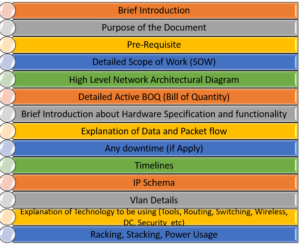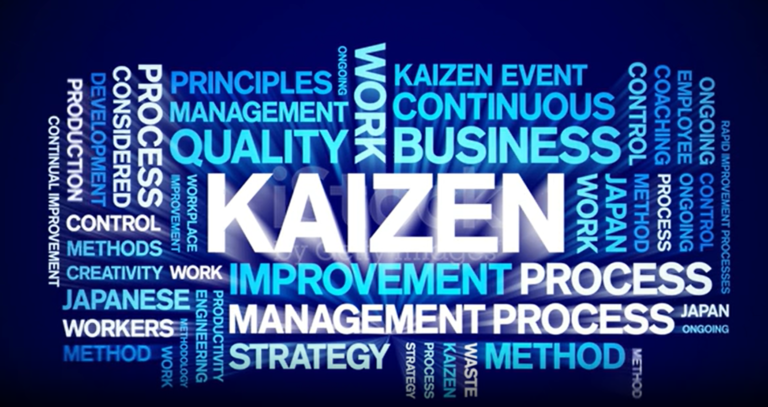HLD ( High Level Document) is a document which help to understand and present a solution in very high level. Based on HLD implementation plan will be carried out. HLD prepared once RFP is floated and MSI or service provider has been selected. MSI will prepare HLD based on Client requirement or most of the cases MSI refers DPR ( Detailed project Report) or RFP ( Request for Proposal),
Why HLD Document Required?
Once RFP floated and Bidder wins the tender and got selected, then now it’s the time to work on ground. Now SI needs to deliver all deliverable agreed or mentioned in RFP.
As RFP & DPR are very high level document to express the requirement and looking for the solution. SI, needs to prepare some document based on RFP, i.e Solution Document, High Level Document, Configuration document, User Acceptance test document, Low level Document and finally sign off and Handed over to Operations.
In Such documents SI needs to validate each and every line items and also needs a checklist of proposed hardware features and specification to support the solution. If any hardware, firmware, modules is not added or not supported then it is the last time to modify, added, remove any hardware in BOQ or solution, because once order placed to hardware to OEM then it is very difficult to modify.
During project implementation, Post Implementation there are multiple document needs to be prepared. As per my experience document should be correct, detailed and contain complete information, as these documents will be always considered during project operations. Everybody will refer these document and act whatever written and approved/sign-off in these document as these documents are base for that project because operation team was not there during implementation phase or team has been changed or left organization, but documents are still there as evidence.
So, my suggestion is always put all possible details/information in these documents or read properly before accepting such document for sign off or operations.
Let’s Discuss about these document types:
Solution or design document :
Based on DPR ( Detailed Project Report) & RFP ( Request for Proposal) vendor / SI needs to share a solution or design document. This document will cater all information with reference to the RFP. This document is the base document and official agreement on the Solution that SI going to implement.
HLD ( High Level Document) :
Based on Solution or Design document approval or agreement with Customer, HLD will be prepared. HLD is a high level document where we explained the solution and implementation plan in details based on design document.
This is the document where customer will get bird’s eye view and we explained that what we are going to do and how. Team will refer this document all Config, BOQ, implementation and output.
Always take sign-off on HLD before start implementations.
Below are some basic or Mandatory information which we should over in HLD to avoid any Implementation delay:
- Brief Introduction
- Purpose of this document
- Pre-requisite
- Scope of Work (SI and Customer)
- High Level Network Architectural Diagram
- Detailed Active BOQ (Bill of Quantity)
- Brief Introduction about Hardware Specification and functionality
- Explanation of Data and Packet flow
- Any downtime (if Apply)
- Timelines
- IP Schema
- Vlan Details
- Explanation of Technology to be using (Tools, Routing, Switching, Wireless, DC, Security etc)
- Racking, Stacking, Power Usage

Lets discuss these points in bit in brief for better understanding
- Brief Introduction : Always start such document with brief introduction about the document, about requirement, Project details, So audience have a brief idea that what is this document is all about.
- Purpose of this document : This section will give information that what all High-Level-Design Document will include, like, design, Overview of Architecture, BOQ, Solution etc.
- Pre-requisite : Before start implementation in every project obviously there are some per-requisites which needs to be completed or require to start. If I am talking about IT Project or Data Centers, then NON-IT DC Infrastructure should be ready includes UPS Power, Earthing, Ducting, LAN Cabling, Racking, HVAC, PAC, Fire Safety, Biometric, security includes Surveillance Cameras, log and entry register, Smoke detector etc.
- Scope of Work (Vendor and Customer) : SOW should be clearly define for both Vendor and customer end. SI should be very much clear about their SOW. Suppose if SI only need to implement IT Active part, then Passive work should be completed, Non-IT works should be ready. Both vendor and SI agreed on their SOWs.
Always use RACI matrix to define SOW.
RACI Matrix
RACI : RACI stand for R= Responsibility, A=Action / Accountability, C= Consulted, I= Informed.
RACI Matrix is very professional tool and way to define SOW.
R= Responsibility: Who will overall Responsibility for particular activity
A=Action : Who will take action on that Activity, who will perform and complete the activity.
C=Consultant : To whom needs to be consult or discuss or take permission before perform any activity. But Consultant will be not responsible for any failure or issue, if occur.
I=Information : Which all team needs to be inform only about that activity.
Example:

High Level Network Architectural Diagram :
- Network Architecture is very Critical and one of important part of any project. It is a symbolic and pictorial view of your network design, connectivity, hardware and design. For Design the network architecture network expertise is required because it is the blue print on the basis actual installation and connectivity will be implemented and also showing usage of all hardware. During preparation of network diag we will get the actual requirement of Ports, Cable, Racks, power etc and also explained how traffic will flow.
Detailed Active BOQ (Bill of Quantity) :
- BOQ is direct related to project commercial and procurement, expense, Budget and profit. Because a vary large part of project cost is involved in Hardware procurement. In some cases Customer procure the hardware but most of the cases SI will procure the hardware from OEMs. If your hardware sizing is not correct based on your requirement or solution, then it will be a huge loss or impact to project cost and time.
Also, during preparation of BOQ always cater future requirement because project should be flexible and Scalable as per future requirement.
Hardware Specification and functionality :
- Always verify the hardware Specification and features as per project requirements and get a compliance checklist with OEM. Also always add a brief introduction of hardware feature and capabilities and where and how you are going to use that hardware in your solution, what is requirement of Power usage, how much space required to mount in rack and what service it will give etc.
Explanation of Data and Packet flow :
- Explanation of Technology to be using (Tools, Routing, Switching, Wireless, DC, Security etc) and how packet will flow, how user will access the service etc.
Timelines :
- Completing a project in a define Timeslines is very important and delivering a project on time is shows perfect solution and planning. Always share activity wise realistic timelines and adhere with it. Create a work breakdown structure (WBS) based on SOW. You can use Gantt Chart, Pert Chart, Excel etc.
IP Schema & VLAN :
- IP Schema & Vlan details should be agreed with Customer as it is very critical requirement. Once you finalize & Configure the IP Schema and VLAN it can not be change easily. Also make ensure that IP Schema should not be have duplicate to avoid any IP Conflict or network Loop.
Any dependencies, down time required:
- If any downtime required during implementation then always plan accordingly and communicate to customer in advance, so that required Change can be raised, approved, communicate to all service user who will be going to impact and planned the downtime accordingly.
Also, you if found Risk or change in solution or design, then do not change without customer agreement and consent. It should be proper communicated with reason, Justification, impact and with an amendment document should be signed by customer.
Force Majeure:
- Force majeure is a French term that literally means “greater force.” It is related to the concept of an act of God, an event such as a hurricane or a tornado, natural causes (fire, storms, floods), governmental or societal actions (war, invasion, civil unrest, labor strikes), infrastructure failures (transportation, energy), so it should be clearly agreed and contracted to claim the same.
Read More : https://techblog.kbrosistechnologies.com/
Visit to our site : https://www.kbrosistechnologies.com/
Watch more Video https://www.youtube.com/channel/UCpcd6IshE1caAbf9EdJd3gw


